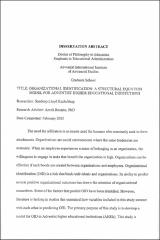Organizational identification : a structural equation model for Adventist higher educational institutions
Abstract
The need for affiliation is an innate need for humans who constantly seek to form
attachments. Organizations are social environments where the same tendencies are
extended. When an employee experiences a sense of belonging in an organization, the
willingness to engage in tasks that benefit the organization is high. Organizations can be
effective if such bonds are created between organizations and employees. Organizational
identification (OID) is a link that binds individuals and organizations. Its ability to predict
several positive organizational outcomes has drawn the attention of organizational
researchers. Some of the factors that predict OID have been identified. However,
literature is lacking in studies that examined how variables included in this study interact
with each other in predicting OID. The primary purpose of this study is to develop a
model for OID in Adventist higher educational institutions (AHEis). This study is
significant because it included more recent organizational variables into OID studies and,
to the knowledge of the researcher, is the first model for OID in AHEis. Based on
literature review, transformational leadership, communication climate, perceived external
prestige, perceived organizational support, and mission attachment were found to have an
influence on OID. Using structural equation modelling, this quantitative study examined
how these variables could be integrated into one model that explains OID in AHEis. A
survey questionnaire consisting of 6 instruments was utilized. Data collected from a total
of 250 respondents who were faculty and staff of seven AHEis were used in the analysis.
The model that was developed as a result of this study explains 41% of variance in OID.
As the model shows, mission attachment (r = 0.36, p < 0.05), perceived organizational
support (r = 0.265, p < 0.05), and perceived external prestige (r = 0.215, p < 0.05) have a
significant direct influence on OID. Additionally, transformational leadership (r = 0.357,
p < 0.05) and communication climate (r = 0.421, p < 0.05) have a significant indirect
influence on OID. Among the variables in the study, perceived organizational support
was the best predictor of OID.
Based on the findings of this study, recommendations were made for
administrators, faculty members and staff, and for future research. One of the major
recommendations for both faculty members and staff, and administrators in AHEis is to
create a supportive work environment. Among others, this study recommends that future
research pursuits may use a qualitative approach to explore the dimensions of OID.


